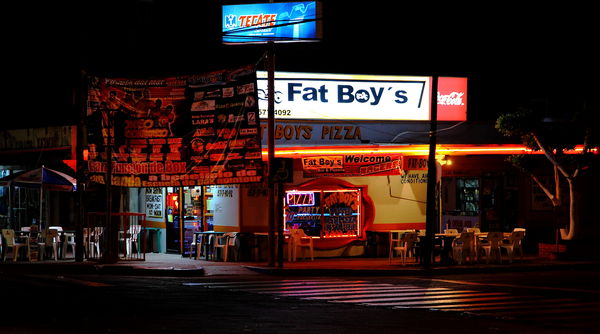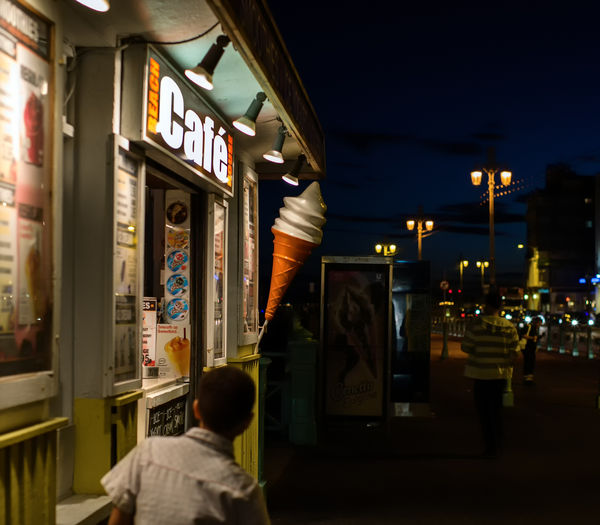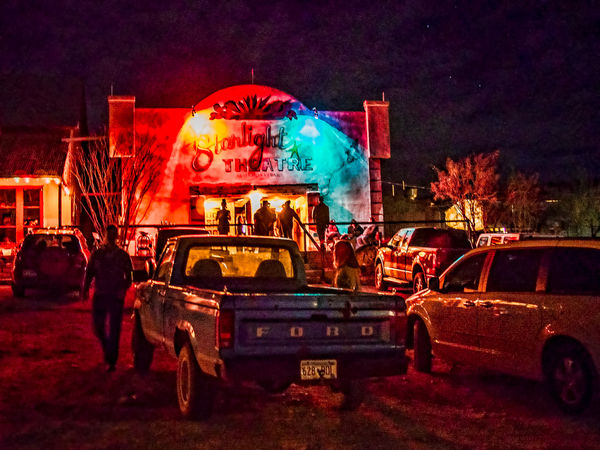Composition: Beyond the Rule of 1/3's
Dec 30, 2014 02:38:50 #
bebo1998 wrote:
I don't understand what you are saying re: shot #1 - this maintenance crew had no "girls".
I really prefer this cleaner version of #2
I really prefer this cleaner version of #2
Version #2 is very nice. This thread isn't about pp, but if it were I would ask, if you wouldn't mind, what did you do to produce such a different result in the second photo? How did you remove the rust?
Dec 30, 2014 02:43:12 #
SharpShooter wrote:
Jim, welcome back. For a second there I thought th... (show quote)
Glad I got a chance to jump in. I seldom have a lot to say about things like which lens has the least barrel distortion, or which body works best with the latest atomic battery, and I intentionally keep my mouth shut about which is the best tripod, but this stuff ....
Headed to San Diego in the morning, then on to San Felipe, Mexico. I'll try to follow the thread as time allows.
Thanks for the comments about the image. I threw it up because I think it illustrated the quandary about how much or how little of the environmental setting to include in an image. The sense of the space and "atmosphere" of the room was an important element to "feeling" the image, as important to me as was the pew. The question was, how much was too much, and how much was too little? And, could I keep the frame balanced? I think those who love to do travel photography face these questions all of the time. In good travel photography, sense of place is important. The question becomes do I want to focus on the place itself, or on someone or something while still giving a solid sense of the surroundings (but not so much as to mute impact)?
Anyway, carry on.
BTW, Frankie sends his regards.
Dec 30, 2014 03:34:50 #
Photographer Jim wrote:
Glad I got a chance to jump in. I seldom have a lo... (show quote)
Jim, I am SOOO jealous. I wanted to go to San Felipe over thanksgiving but was to tied up.
This doesn't have anything to do with this thread but I'm posting this pic for you. If I'd seen it much earlier I could have gotten some people sitting out in front of Fat Boy's!! See if you can get that pic!! :thumbup:
SS
Dec 30, 2014 05:25:22 #
Human interest is always good in street scenes, the small boy furtively approaching the café for a late night ice cream fix perhaps?
Dec 30, 2014 08:21:43 #
Photographer Jim wrote:
My point is (finally, you say), that when thinking about environmental compositions it is key to consciously think about which type of shot you are going for, and include as much, and only as much, of the surrounding environment needed to accomplish that goal.
OK, just for fun, how does this crop fit into the idea? Illustration? Contradiction? Something altogether different?
My point is (finally, you say), that when thinking about environmental compositions it is key to consciously think about which type of shot you are going for, and include as much, and only as much, of the surrounding environment needed to accomplish that goal.
OK, just for fun, how does this crop fit into the idea? Illustration? Contradiction? Something altogether different?
Your point is taken, Jim, and it is the thing I struggle with the most. Finding the exact crop I want in my camera at the scene is so hard. I want to .. I want to keep every pixel, but most often I see the crop after I get home.
As for the image you have posted, I wonder if a square crop losing the green mold at the top. I hate to let some good green mold go to waste. I feel that it is a distraction from the more interesting element of the lamp .. my eyes went immediately to the green and missed the lamp at first.
Dec 30, 2014 08:26:58 #
Graham Smith wrote:
Human interest is always good in street scenes, the small boy furtively approaching the café for a late night ice cream fix perhaps?
I hope, I hope, I hope:-)
Graham you are quite the story teller :thumbup:
Dec 30, 2014 08:30:50 #
Clive22 wrote:
Version #2 is very nice. This thread isn't about pp, but if it were I would ask, if you wouldn't mind, what did you do to produce such a
different result in the second photo? How did you remove the rust?
different result in the second photo? How did you remove the rust?
I'll have to re-think the process, (5 years ago) but I use Smart Photo Editor a lot. A little goes a long way. I'll pm you later. Ok?
Dec 30, 2014 08:38:09 #
I am going to have to put aside a day to read this thread.
A lot to digest.
Thanks SS.
A lot to digest.
Thanks SS.
Dec 30, 2014 09:22:29 #
Nightski wrote:
Your point is taken, Jim, and it is the thing I st... (show quote)
I think that is the important issue when thinking about these "environmental" compositions. When we think about it, everything we photograph is found in its own setting. What we are dealing with here is the question of when and how much of the setting do we show in a particular image. my bias is that no matter how interesting the surrounding environment is, if it not necessary for understanding the image, include only as much as is needed to keep the overall image balanced. If it is an important element for the overall understanding of the image, include only as much as is proportional to its importance.
The image I threw out there for consideration presented me with that dilemma at the time I shot it (so please forgive my talking a bit about it. I promise I offer my comments as illustration of the discussion's topic, and apologize if it comes across as self-promotion). For me, the room was as key to the image as the pew. I wanted to get across the sense of space (tall, massive, old, austere) which contributed to the starkness and contemplative nature of the room as might be experienced if one were sitting quietly on the pew like an old padre or monk my have done, but still let the pew carry the primary weight in the image.
To do that I used a vertical rather than horizontal or square frame. This also allowed me to make use of the Rule of Thirds (ironic?), (floor/wall corner along bottom third line; seam in the wall on left vertical thirds line; pew near right lower power point; diagonal formed by pew leading toward lower right. I considered cloning out moss at one point, but decided against it. I feel it is needed to balance the visual weight in the lower right by adding some weight into the upper left.
I took a few shots cropped in closer on the pew, but found them very unsatisfactory. Without its surroundings, it lacked the sense of place I feel is important component of the image. I also took some shots with a much wider view, but in those the room became too dominant and the pew too insignificant. So back to our dilemma. How much of the setting is too much, and how much is too little?
Dec 30, 2014 09:33:16 #
Photographer Jim wrote:
I think that is the important issue when thinking ... (show quote)
Hello Jim, I get the feeling that some posters may be confusing "compositional environment" i.e. keeping enough of the surrounding environment to give context, with environmental photography i.e. taking pictures of environmental issues. I think that when using the environment to give a subject context it should be pared down to the minimum amount possible, less is more.
Graham
Dec 30, 2014 09:38:42 #
Environmental: Inspired to dig this out by SS and Graham S's nighttime environmental photos. Over processed on purpose because this is how the Starlight feels to me - it's my favorite hangout when visiting Big Bend NP.
Are the vehicles superfluous or important elements?
Are the vehicles superfluous or important elements?
Dec 30, 2014 09:45:35 #
Photographer Jim wrote:
I think that is the important issue when thinking ... (show quote)
Thanks for posting this, it is very interesting to me to see how good photographers think through an image. I struggle with the how much is too much/how much is too little question all the time, usually erring on the side of too much, partly because that is my first instinct and partly because you can crop but can't add back. What I consider distractions and what other folks consider distractions sometimes differs. I doubt I'll ever have the spare compositional style that some folks have, but I keep trying to grow.
Dec 30, 2014 09:54:23 #
minniev wrote:
Environmental: Inspired to dig this out by SS and Graham S's nighttime environmental photos. Over processed on purpose because this is how the Starlight feels to me - it's my favorite hangout when visiting Big Bend NP.
Are the vehicles superfluous or important elements?
Are the vehicles superfluous or important elements?
Hello Minnie, your shot tells me quite a lot about the place, busy with people coming and going, perhaps slightly trashy in a very nice way. Including any more of the places environment would be over egging the pudding. I do wonder what it looks like in daylight, many of these places, in the cold light of day, look very tired, worn and scruffy having seen better days.
Graham
Dec 30, 2014 09:56:11 #
Graham Smith wrote:
Hello Jim, I get the feeling that some posters may be confusing "compositional environment" i.e. keeping enough of the surrounding environment to give context, with environmental photography i.e. taking pictures of environmental issues. I think that when using the environment to give a subject context it should be pared down to the minimum amount possible, less is more.
Graham
Graham
Point taken, thank you Graham.
Dec 30, 2014 10:22:30 #
If you want to reply, then register here. Registration is free and your account is created instantly, so you can post right away.










